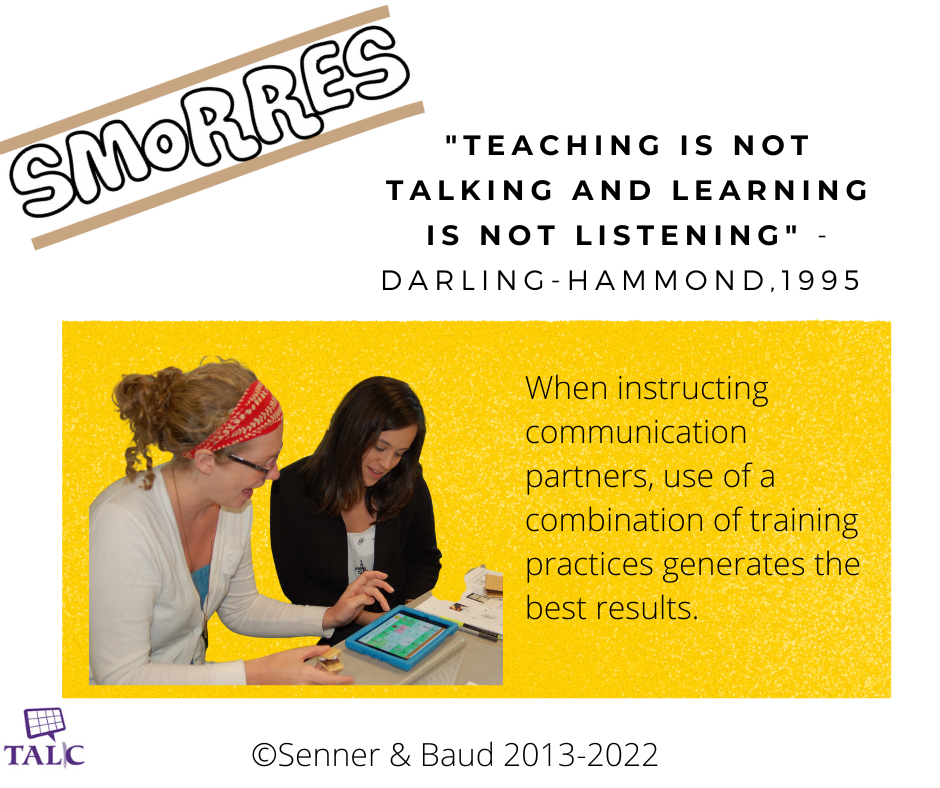Welcome back to Let's Talk AAC - a series of questions and topics for discussion. NWACS will occasionally post a question or topic with related information. Join in the conversation! Add your experiences, resources, related research, etc. in the comments so we can all learn and benefit from each other's knowledge and experience.
by Jill E. Senner, PhD, CCC-SLP and Matthew R. Baud, MS, CCC-SLP (Speech-Language Pathologists)
reading time: 2 minutes
This month we welcome Dr. Jill Senner and Matthew Baud to the NWACS blog. They developed the SMoRRES® approach to AAC partner training. The views expressed in this post are that of the authors and do not necessarily reflect the views and policies of NWACS. No endorsement by NWACS is implied regarding any device, manufacturer, resource, or strategy mentioned.
Right #9 of the Communication Bill of Rights reads: The right to access interventions and supports that improve communication.
As an AAC parent or professional, what do you think of when you hear the word intervention? We’re guessing that most of you think about a strategy used during 1:1 speech therapy or maybe applied behavior analysis (ABA). What if someone said that supporting communication partners is an intervention? Yup, it’s true!
Sarah Blackstone has said that “Being an effective communication partner or AAC facilitator is not intuitive. It often requires one to change long-established, unconscious ways of communicating” (2006, p. 12). In fact, the research tells us that untrained family members, teachers, therapists, and even peers can
monopolize conversational turns,
control the topic of conversation,
and demand specific responses.
All of these habits may negatively affect communication development in AAC communicators.
There is a growing body of research evidence that communication partner instruction is an intervention. AAC communicators experience numerous communication gains as a result of parent and school staff instruction. Documented improvements include
increased conversational turns,
increased independence (i.e., initiation),
increased utterance length,
increased use of unique words,
and increased frequency of communication.
However, what we teach is as important as how we teach. We know that AAC modeling, in other words, partner-augmented input, is an effective strategy. However, it’s unlikely that a parent or teacher can simply read a handout or watch a YouTube video and then start modeling at home or in the classroom. Here the evidence suggests that using multiple instructional elements such as
talking about the importance of modeling,
demonstrating modeling on a device,
allowing communication partners time for hands-on practice modeling,
as well as coaching modeling in the natural environment,
are all important to changing communication patterns at home or in the classroom. This is why the SMoRRES® Training Program contains all of these features and more.
After participating in the SMoRRES® Training Program, parents and school staff reported
increased familiarity,
more confidence,
and better comfort using the child or student’s speech-generating device (SGD).
Unfortunately, even though we know that using multiple training elements is an effective practice, the most common type of training is still a one-day in-service. How can we bridge this gap?
We know how hard it is to read a research paper and then implement a program as intended. This is why we provide several free SMoRRES® resources on the Technology & Language Center, PC website for those supporting AAC communicators including streaming videos, a poster, handouts in English and Spanish, and more! Increase the use of evidence-based practices in your trainings today to support communication partners and improve communication.
References:
Blackstone (2006). Training partners: Learning more about what to do. ACN, 18, 12-16
Senner, J. E., Post, K. A., Baud, M. R., Patterson, B., Bolin, B., Lopez, J. & Williams, E. (2019). Effects of parent instruction in partner-augmented input on parent and child speech generating device use. Technology and Disability, 31, 27-38. DOI: 10.3233/TAD-190228
Senner, J. E. & Baud, M. R. (2017). The use of an 8-Step instructional model to train school staff in partner-augmented input. Communication Disorders Quarterly, 38(2), 89-95. DOI:10.1177/1525740116651251
Related resources:
Check out our collection of other free resources for training communication partners!
Related posts:







